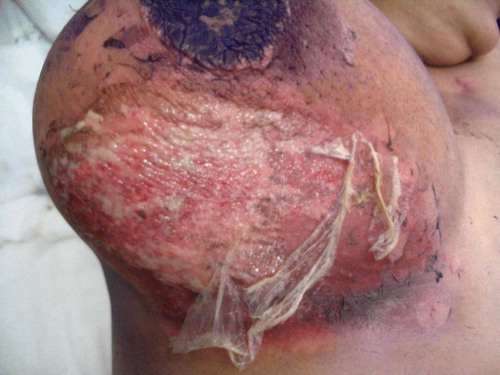To the Editor
A 57 year old postmenopausal female was diagnosed as a case of locally advanced carcinoma right breast (T4bN1M0). After anthracycline based neoadjuvant chemotherapy, she achieved a clinical partial response and underwent breast conservation surgery. Histopathology revealed infiltrating duct carcinoma grade III with a pathological tumor size of 2×2×1.5 cm. Four of 15 axillary nodes were involved. She subsequently received eight cycles of adjuvant weekly paclitaxel. Whole breast radiotherapy (WBRT) was then started with standard bitangential portals using 10 MV photons to a dose of 50 Gray in 25 fractions (5 fractions per week). She also received supraclavicular irradiation to a dose of 50 Gray in 25 fractions with direct anterior portal using 6 MV photons.
At completion of whole breast radiotherapy, the patient developed grade II skin reactions in the inframammary fold, which is an expected phenomenon. She was planned for boost radiotherapy to the post operative tumour bed (upper quadrant). However, she developed an episode of fever with rigors the same day and was started on a course of chloroquine by the consultant physician (600 mg stat, 300 mg after 6 hours and 150 mg b.d. for 2 days). On the 3rd day she presented in our clinic with dramatic increase in moist desquamation which involved almost all the infra mammary region along with erythema and hyperemia in lateral aspect of the breast (). She was managed conservatively with amniotic membrane dressings and the area showed complete epithelisation in 2 weeks.
Figure 1. Large area of moist desquamation in the inframammary fold of the breast. Amniotic membrane has been placed in situ.

Although the radiopotentiating activity of chloroquine is well known, its mechanism is not well elucidated. This activity has been attributed to chloroquine's property of DNA intercalation and consequent hinderance in DNA repair Citation[1], Citation[2]. The other probable mechanism of biological effects of this drug (including radiosensitisation) is the lysosomotropic property of chloroquine. Being a weak base, chloroquine accumulates in several intracellular organelles including lysosomes, increasing their volume and permeability. This is exacerbated in post radiotherapy damaged cells in which lysosomal permeability has been increased by radiation and thus can cause the release of proteolytic enzymes, which can damage cellular proteins Citation[2].
Our patient had a severe moist desquamation with rapid progression post chloroquine intake and the drug seemed to be the most probable cause. We reviewed the treatment plan of the patient and did not see any error. No topical or systemic medication was used by the patient. In the a previous report, a 54-year-old woman with rheumatoid arthritis treated with 600 mg/day of hydroxylchloroquine sulfate also developed moist desquamation, after several months of radiotherapy to the chest wall for a breast tumour Citation[3]. We have earlier too reported a young girl with brain stem glioma who received chloroquine during a course of radiotherapy and developed excessive reactions on the scalp Citation[4]. The present case has confirmed the need for avoiding chloroquine in antimalarial doses and schedules during radiotherapy to avoid flaring of skin reactions.
Isolated reports have used chloroquine as a radiosensitiser in cancer management. Sotelo and colleagues did a randomised placebo-controlled trial of 30 patients with surgically confirmed glioblastoma. All patients received conventional chemotherapy and radiotherapy. Although not significantly different, the rate of death in patients receiving chloroquine was about half of that in patients receiving placebo (p = 0.139) Citation[1].
While our present report strongly cautions against using chloroquine in routine antimalarial schedules during a course of radiotherapy, the clinical import probably lies elsewhere. The big challenge lies in pharmaceutically trying to harness chloroquine's potential for cheap and effective radiosensitisation. If indeed proven, then by means of suitable dose schedules, the tables can be turned for immense therapeutic gain.
References
- Sotelo J, Briceno E, Lopez-Gonzalez MA. Adding chloroquine to conventional treatment for glioblastoma multiforme: A randomized, double-blind, placebo-controlled trial. Ann Intern Med 2006; 144: 337–43
- Savarino A, Lucia MB, Giordano F, Cauda R. Risks and benefits of chloroquine use in anticancer strategies. Lancet Oncol 2006; 7: 792–3
- Utley JF, Sachatello CR, Maruyama Y. Radiosensitization of normal tissue by chloroquine. Radiology 1977; 124: 255–7
- Rustogi A, Munshi A, Jalali R. Unexpected skin reaction induced by radiotherapy after chloroquine use. Lancet Oncol 2006; 7: 55–6